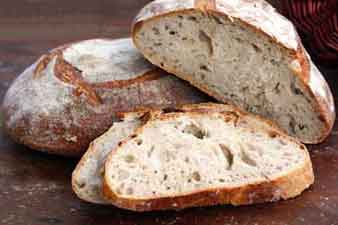Delicious sourdough bread is easy to make with this no-knead method. Use the same sourdough starter that you would use when making kneaded sourdough, but skip the muss and fuss of kneading. Spend more time enjoying its fresh-baked goodness from your oven!
Ingredients

| Amount | Description |
|---|---|
| 3-1/2 cups | Unbleached white bread flour, plus more as needed |
| 1-3/4 teaspoons | Salt |
| 1/4 teaspoon | Instant or bread-machine yeast |
| 1 tablespoon | Vegetable oil, plus more for pan and dough top |
| 2/3 cup | Sourdough starter |
| 1-1/2 cups | Ice water, plus more as needed |
Process
First Rise
In a large bowl, thoroughly stir together the flour, salt, and yeast. In another bowl or measuring cup, whisk the oil and starter into the water. Vigorously stir the mixture into the bowl with the flour, scraping down the sides and mixing just until the ingredients are thoroughly blended. If the mixture is too dry to incorporate all the flour, a bit at a time, stir in just enough more ice water to blend the ingredients; don't over-moisten, as the dough should be very stiff. If necessary, stir in enough more flour to stiffen it. Brush or spray the top with oil. Cover the bowl with plastic wrap. Refrigerate the dough 3 to 10 hours. Then let rise at cool room temperature 18 to 24 hours. If convenient, vigorously stir the dough once partway through the rise.
Second Rise
Vigorously stir the dough, adding more flour as needed to yield a very stiff and hard-to-stir dough. Then, using a well-oiled rubber spatula, fold the dough in towards the center, working your way all the way around the bowl. Let the dough rest for 10 minutes. Invert the dough so the underside is up. Sprinkle evenly with 3 to 4 tablespoons of flour. Working in the bowl, shape the dough into a ball, roll it in the flour until coated all over, then work in the flour until it holds its shape. Lightly dusting with flour as needed, form the dough into an evenly shaped high-domed 6-inch diameter round by firmly tucking the edges under all the way around; work gently, as the dough is tender and done to tearing.
Gently transfer the loaf to an oiled 3-1/2 to 4-quart dutch oven or other large, heavy pot. Dust the loaf top with more flour, smoothing out evenly. Using a well-oiled serrated knife, make 3 or 4 parallel shallow slashes across the top. (The slashing isn't optional - do it.) Then, working on a diagonal, slash 3 or 4 more times diagonally across the first set to create a diamond pattern. Brush or spray the dough with oil. Cover the pot with its lid. Let rise until the dough doubles from its deflated size using any of these methods: Stand at warm room temperature for a 1-1/2 to 2-1/2 hour regular rise; or in a turned-off microwave along wit a cup of boiling hot water for a 1 to 2-1/2 hour accelerated rise. Or, for an extended rise, refrigerate for 4 to 24 hours, then set out at room temperature. Continue the rise until the dough doubles in size.
Baking Preliminaries
15 minutes before baking time, put a rack in the lower third of the oven; preheat to 450F. Generously sprinkle or spray the loaf with water.
Baking
Reduce the heat to 425F. Bake in the lower rack, covered for 55 to 60 minutes, or until the loaf is lightly browned and crusty. Uncover and continue baking for 10 to 15 minutes more, until a skewer inserted in the thickest part comes out with just a few particles on the end (or until the center registers 207 to 209F on an instant-read thermometer.) Then bake for 5 minutes longer to ensure the center is done. Cool on a wire rack for 10 minutes. Turn the loaf onto the rack and cool thoroughly. The loaf will keep at room temperature for 3 days or, frozen for 2 months. If storing at room temperature, drape with a tea towel or put into a paper bag to store.
CSS Statements
body { font-size:small; /* for IE5/Win */ voice-family: "\"}\""; voice-family: inherit; font-size: small; /* for compliant browsers */ color:#714116; font-family:Verdana, Arial, Helvetica, sans-serif; margin-left: 0; } html>body { /* for Opera */ font-size:small; }
img { border: 0; }
table { float: right; }
h2 { margin-left: 40; }
h3 { color: #C19A77; margin-left: 40; }
.nav { float: left; width: 100%; margin: 0; padding: 10px 0 0 36px; list-style: none; }
.nav a { float:right; display: block; margin: 0 1px 0 0; padding: 4px 8px; color: #714116; text-decoration: none; }
.nav a:hover { color: #C19A77; text-decoration: none; }
#main { position: absolute; left: 50%; width: 900px; margin-left: -450px; } // This centers the content
#header { margin-bottom: 60px; }
#content { margin-top: 10px; }
#note { float: right; }
Gloria Rea
